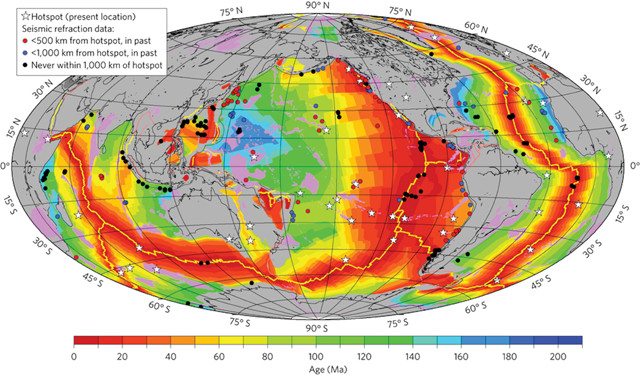
by Mary Caperton Morton Thursday, April 6, 2017

This map, created by researchers at the University of Texas at Austin, depicts the ages of ocean crust in millions of years before present (Ma). Warm shades represent younger crust and cool shades represent progressively older crust. Modern mid-ocean spreading ridges are indicated by yellow lines. Credit: Harm Van Avendonk.
Oceanic crust formed at mid-ocean spreading centers, like the Mid-Atlantic Ridge, is recycled back into the mantle at subduction zones. Aside from isolated chunks that might be even older, the oldest crust found on Earth today is thought to be about 200 million years old. This old crust, portions of which are found along the outer margins of the Atlantic, Pacific and Indian oceans, is much thicker than the crust being produced today — in some places by almost 2 kilometers — according to a new study, a finding that may suggest that Earth’s supercontinent cycle affects how Earth’s interior cools.
The thickness of Earth’s oceanic crust is directly related to the temperature of the mantle at its time of formation, says Harm Van Avendonk, a geophysicist at the University of Texas at Austin and lead author of the new study in Nature Geoscience. A hotter mantle produces more melt, which is extruded at mid-ocean spreading centers and creates thicker oceanic crust. Thus, Van Avendonk says, crustal “thickness provides a clue that allows us to look back in time” at the thermal history of the planet’s mantle.
Van Avendonk and his colleagues analyzed a dataset of more than 230 crustal thickness measurements pulled from seismic refraction data collected in ocean basins worldwide. They found that crust formed roughly 170 million years ago was 1.7 kilometers thicker on average than newly formed crust. The observation suggests, according to the researchers, that the mantle may have gotten a thermal boost from the breakup of the supercontinent Pangea, which was intact from about 300 million to 170 million years ago before splitting up in the Middle Jurassic. “The mantle that lay beneath the supercontinent may have been anomalously hot because it was being insulated by the supercontinent,” Van Avendonk says. Once Pangea began to break up, the mantle underneath where it had been could cool more rapidly, setting off a cooling trend that continues to this day.
This idea has been proposed previously, but was theoretical, says Adrian Lenardic, a geodynamacist at Rice University in Houston, who was not involved in the new study but wrote an accompanying commentary. Scientists have “talked a lot about what formation and breakup of a supercontinent might do to mantle flow inside the Earth,” Lenardic says. One of the testable outcomes predicted by geodynamic models is that ocean crust should be thick following a breakup and then get progressively thinner with time, he says. “There are some gaps in the [new] dataset, but there’s a clear, general trend” supporting that prediction, he says.
An interesting question related to this study is whether the mantle-insulating effect of the supercontinent may have played a role in its own breakup, Lenardic says. “The supercontinent would have created a lateral temperature gradient, with [heat] flow moving from hot to cold, potentially creating instability under the landmass.”
The formation and breakup of supercontinents appear to be cyclical, occurring as many as seven times in Earth’s history. “It may be possible that supercontinents such as Pangea are inherently unstable,” Van Avendonk says, “in part because of the way they insulate the underlying mantle.”
© 2008-2021. All rights reserved. Any copying, redistribution or retransmission of any of the contents of this service without the expressed written permission of the American Geosciences Institute is expressly prohibited. Click here for all copyright requests.